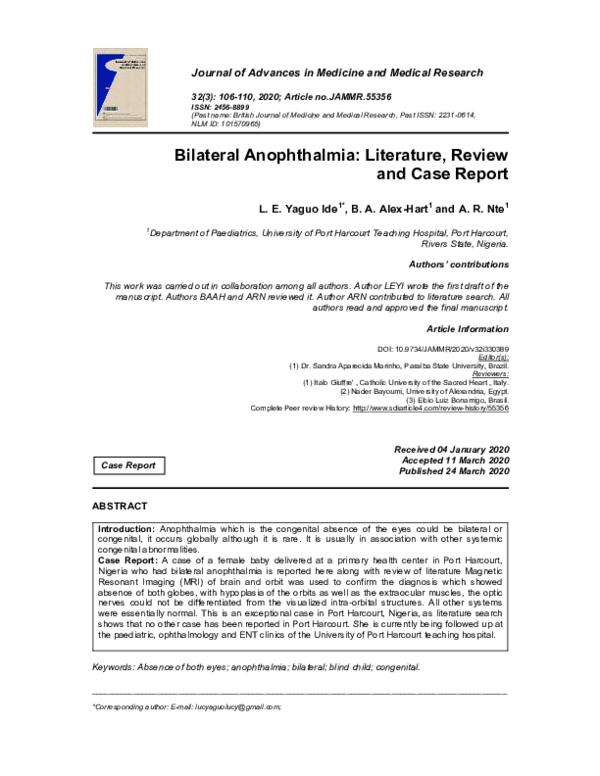Bilateral Anophthalmia: Research, Treatment Options, And Future Prospects

Table of Contents
Bilateral anophthalmia, a rare condition characterized by the absence of both eyes at birth, profoundly impacts an individual's life. Understanding this congenital anomaly, its causes, and available treatments is crucial for improving the quality of life for those affected. This article explores the current research on bilateral anophthalmia, examines available treatment options, and highlights the promising avenues of future research and development, focusing on the hope for improved outcomes. We delve into the complexities of congenital anophthalmia, discussing the absence of eyes and the challenges it presents.
Current Research on Bilateral Anophthalmia: Unveiling the Causes and Mechanisms
Understanding the etiology of bilateral anophthalmia is paramount for developing effective treatments. Research currently focuses on genetic and environmental factors.
Genetic Factors and Bilateral Anophthalmia
Genetic mutations play a significant role in the development of anophthalmia. Several genes have been identified as contributing factors, highlighting the complexity of this condition. Research into the genetic basis of bilateral anophthalmia is crucial for understanding the disease mechanisms.
- AN2 gene: Mutations in this gene are frequently associated with anophthalmia and microphthalmia (abnormally small eyes).
- SOX2 gene: This gene plays a critical role in eye development; mutations can lead to severe eye defects, including anophthalmia.
- PAX6 gene: Mutations in PAX6 are linked to various eye malformations, including anophthalmia, highlighting its essential role in eye formation.
- Genetic testing: Advances in genetic sequencing techniques are enabling researchers to identify new genes and pinpoint specific mutations responsible for bilateral anophthalmia.
Environmental Factors and Bilateral Anophthalmia
Environmental factors during fetal development can also contribute to the occurrence of bilateral anophthalmia. These environmental risk factors are often difficult to isolate and study.
- Teratogens: Exposure to certain teratogens (substances that cause birth defects) during pregnancy can disrupt normal eye development.
- Maternal health: Factors such as maternal infections or nutritional deficiencies during pregnancy have been linked to increased risks of anophthalmia.
- Fetal development: Disruptions in the intricate processes of fetal development can result in the absence of eyes.
Animal Models and Bilateral Anophthalmia Research
Animal models, such as mice and zebrafish, are invaluable tools for studying the mechanisms underlying bilateral anophthalmia. These animal models allow researchers to investigate the effects of gene mutations and environmental factors in a controlled setting.
- Zebrafish: The transparency of zebrafish embryos makes them particularly useful for studying eye development.
- Mouse models: Genetically modified mice are used to mimic human genetic mutations associated with anophthalmia.
- Experimental studies: These studies provide insights into the complex signaling pathways and molecular mechanisms that govern eye formation.
Treatment Options for Bilateral Anophthalmia: Providing Support and Enhancing Quality of Life
While a cure for bilateral anophthalmia remains elusive, several treatment options aim to improve the quality of life for affected individuals.
Prosthetic Eyes (Orbital Implants)
Ocular prosthetics play a vital role in improving the appearance and social integration of individuals with bilateral anophthalmia. These eye implants provide a more natural look, enhancing self-esteem and confidence.
- Types of prosthetics: Prosthetic eyes can be made from various materials, including acrylic, glass, or silicone, each with its advantages and disadvantages regarding comfort, durability, and appearance.
- Cosmetic improvement: Properly fitted prosthetic fitting significantly enhances the cosmetic appearance.
- Advantages: Improved appearance, increased self-confidence, better social interaction.
- Disadvantages: Requires periodic replacement, potential for irritation or discomfort.
Sensory Aids and Assistive Technologies
Assistive technologies play a crucial role in helping individuals with bilateral anophthalmia navigate their world and lead independent lives.
- Sensory aids: These can include enhanced audio equipment, tactile devices, and specialized software.
- Assistive technology: This could involve mobility aids such as canes or guide dogs, and advanced communication devices.
- Benefits: Increased independence, improved mobility, enhanced communication.
Psychological and Social Support
Psychological support is essential for individuals with bilateral anophthalmia and their families. Psychological support helps in adapting to the condition and fosters social integration.
- Therapy: Individual and family therapy addresses emotional challenges and improves coping mechanisms.
- Support groups: Connecting with others facing similar challenges provides a valuable source of emotional support and shared experiences.
- Social integration strategies: Interventions aimed at improving social interactions and inclusion within communities are crucial.
Future Prospects and Emerging Therapies for Bilateral Anophthalmia: Hope for the Future
Significant advancements in medical research offer hope for future treatments for bilateral anophthalmia.
Stem Cell Therapy and Regenerative Medicine
Stem cell therapy holds immense potential for regenerating damaged or missing eye tissues.
- Eye tissue regeneration: Researchers are exploring the use of stem cells to induce the growth of new eye structures.
- Clinical trials: Early clinical trials are underway, though much research remains to be done before widespread clinical application is possible.
- Promising areas: Studies focusing on induced pluripotent stem cells (iPSCs) show promise in differentiating into various eye tissues.
Gene Therapy for Bilateral Anophthalmia
Gene therapy approaches may one day offer a way to correct the underlying genetic defects responsible for bilateral anophthalmia.
- Genetic correction: This targeted approach aims to repair or replace faulty genes.
- Challenges: Gene therapy is complex and faces challenges in efficient gene delivery and targeting.
- Potential: Successful gene therapy could potentially prevent the condition from developing or mitigate its severity.
Advanced Prosthetic Technologies
Advanced prosthetics are being developed that offer more realistic and functional eye replacements.
- Bionic eyes: Research is underway to integrate prosthetic eyes with neural implants to restore some level of vision.
- Neural implants: This involves stimulating the visual cortex to create the sensation of sight.
- Advancements: Improvements in materials, miniaturization, and integration with nerve stimulation promise more sophisticated prosthetics in the future.
Conclusion: Looking Ahead with Bilateral Anophthalmia Research
Bilateral anophthalmia presents significant challenges, but ongoing research in genetics, regenerative medicine, and advanced prosthetics offers increasing hope for improved treatment options and quality of life for affected individuals. The understanding of genetic and environmental factors continues to improve, paving the way for targeted therapies. The development of more sophisticated prosthetics and the potential of stem cell and gene therapy hold tremendous promise. We encourage you to learn more about bilateral anophthalmia research and support organizations dedicated to improving the lives of those affected by this rare condition. [Link to relevant organization 1] [Link to relevant organization 2] [Link to relevant research institution]. Your contribution, whether through awareness, fundraising, or participation in research studies, can significantly impact the future of bilateral anophthalmia treatment and support.

Featured Posts
-
 Knicks Vs Pistons Magic Johnsons Bold Prediction
May 12, 2025
Knicks Vs Pistons Magic Johnsons Bold Prediction
May 12, 2025 -
 Cuando Comienza El Campeonato Uruguayo De Segunda Division 2025
May 12, 2025
Cuando Comienza El Campeonato Uruguayo De Segunda Division 2025
May 12, 2025 -
 Why Fans Believe Henry Cavill Could Be Wolverine In Marvels World War Hulk
May 12, 2025
Why Fans Believe Henry Cavill Could Be Wolverine In Marvels World War Hulk
May 12, 2025 -
 Payton Pritchards Sixth Man Of The Year Candidacy Factors Behind His Improvement
May 12, 2025
Payton Pritchards Sixth Man Of The Year Candidacy Factors Behind His Improvement
May 12, 2025 -
 Grand Slam Track Meet Michael Johnson Promises Speed Star Power And Significant Prize Money
May 12, 2025
Grand Slam Track Meet Michael Johnson Promises Speed Star Power And Significant Prize Money
May 12, 2025
Latest Posts
-
 Sylvester Stallone Reveals His Favorite Rocky Film An Emotional Rollercoaster
May 12, 2025
Sylvester Stallone Reveals His Favorite Rocky Film An Emotional Rollercoaster
May 12, 2025 -
 Which Rocky Movie Touches Sylvester Stallone The Most Exploring The Franchises Emotional Core
May 12, 2025
Which Rocky Movie Touches Sylvester Stallone The Most Exploring The Franchises Emotional Core
May 12, 2025 -
 The Most Emotional Rocky Movie According To Sylvester Stallone A Critical Analysis
May 12, 2025
The Most Emotional Rocky Movie According To Sylvester Stallone A Critical Analysis
May 12, 2025 -
 Sylvester Stallone Picks His Top Rocky Film Why This One Is So Emotional
May 12, 2025
Sylvester Stallone Picks His Top Rocky Film Why This One Is So Emotional
May 12, 2025 -
 Exploring Sylvester Stallones Only Non Starring Directorial Effort
May 12, 2025
Exploring Sylvester Stallones Only Non Starring Directorial Effort
May 12, 2025
